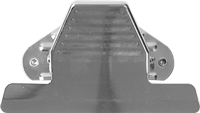First, qualitative judge MOS type field effect tube is good or bad First use a multimeter R×10kΩ (9V or 15V built-in battery), connect the negative (black) to the gate (G), and the positive (red) to the source (S). Charging between the gate and the source, the multimeter's hand is slightly deflected. Switch to the multimeter R×1Ω, then connect the negative probe to the drain (D) and the pen to the source (S). If the indicator value of the multimeter is a few ohms, the FET is good. Second, the qualitative judgment of the junction of the field effect transistor electrode Move the multimeter to R×100, and the red pen will be connected to any one leg. The black pen will be connected to another leg to make the third leg vacant. If it is found that there is a slight swing of the hands, it is proved that the third foot is the gate. In order to obtain more obvious observation effects, you can also use the human body close to or touch the dangling foot with your fingers, as long as you see the hands for a large deflection, which means that the dangling foot is the grid, and the other two feet are the source and drain, respectively. Reason for judgment: The input resistance of JFET is greater than 100MΩ, and the transconductance is very high. When the gate is open, the space electromagnetic field can easily induce a voltage signal on the gate, so that the tube tends to cut off or tends to conduct. If the human body induced voltage is directly applied to the grid, the above phenomenon will be more pronounced because the input disturbance signal is strong. If the hands are deflected to the left, it means that the tube tends to be cut off, and the drain-source resistance RDS increases, and the drain-source current decreases by IDS. Conversely, the hands are deflected to the right, indicating that the tubes tend to conduct, RDS ↓, IDS ↑. However, the direction in which the hands are deflected depends on the polarity of the induced voltage (forward voltage or reverse voltage) and the operating point of the tube. Precautions: (1) Tests show that when the two hands are insulated from the D and S poles and only touch the grid, the hands are generally deflected to the left. However, if both hands touch the D and S poles, and the gate is touched with a finger, it may be observed that the hands are deflected to the right. The reason for this is that several parts of the body and the resistors act as a bias to the FETs and allow them to enter the saturation region. (2) You can also use the tip of the tongue to hold the gate. The phenomenon is the same as above. Third, crystal transistor pin discrimination The transistor is composed of a die (two PN junctions), three electrodes and a tube shell. The three electrodes are called the collector electrode c, the emitter electrode e and the base electrode b. The current common transistor is a silicon plane tube, which is divided into PNP and NPN type two types. Now the niobium alloy tube is rare. Here is how to use a multimeter to measure the three pins of a triode simply. 1, find out the base, and determine the type (NPN or PNP) For PNP type triodes, C and E poles are the positive poles of their two internal PN junctions respectively, and B poles are their common negative poles. For NPN triodes, the opposite is true: C and E poles are respectively two PN junctions. The negative pole, and B pole is their common positive pole, according to the characteristic that the PN junction forward resistance is small and the reverse resistance is large, it is very convenient to judge the type of the base and the tube. The specific method is as follows: Place the multimeter on the R×100 or R×1K file. The red pen contacts a pin, and the black probes are connected to the other two pins respectively, so that three groups (two times each) of the readings can be obtained. When one group of the two measurements is a low value of several hundred ohms When the public pin is a red meter, the contact is the base, and the transistor's pipe type is PNP type; if the common pin is a black meter pen, the contact is also the base, and the transistor's pipe type is NPN type. . 2, identify the emitter and collector As the triode is manufactured, the doping concentration of the two P regions or the two N regions is different. If the emitter and the collector are used correctly, the triode has a strong amplifying ability, whereas if the emitter and the collector are used interchangeably, The amplification ability is very weak, and the emitter and collector of the tube can be distinguished from each other. After the tube type and the base electrode b are discriminated, the following methods can be used to discriminate the collector electrode and the emitter electrode. Put the multimeter on the R×1K file. The base is pinched with the other pin by hand (be careful not to allow the electrodes to collide directly). In order to make the measurement obvious, moisten the finger and attach the red probe to the pin that is pinched to the base. The black lead pen is connected to another pin, and observe the amplitude of the multimeter's hand swinging to the right. Then align the two pins and repeat the above measurement procedure. Compare the amplitude of the hands swinging to the right in the two measurements and find out how large the swing amplitude is. For PNP type triodes, connect the black lead to the pin that is pinched to the base and repeat the above experiment to find out if the hand is large. For the NPN type, the black lead is the collector and the red lead is connected. Is the emitter. For the PNP type, the red lead is the collector and the black lead is the emitter. The principle of this type of discriminating electrode method is to use a battery inside the multimeter to apply voltage to the collector and emitter of the triode so as to have amplification capability. When the base electrode and the collector electrode are squeezed by hand, it is equivalent to adding a positive bias current to the transistor through the resistance of the hand to make it conduct. At this time, the amplitude of the zooming ability is reflected by the amplitude of the hand pin to the right, so it can be correctly judged. Out emitter, collector come. Fill Light,Ring Light,Led Ring Light,Selfie Ring Light Shaoxing Shangyu Kenuo Photographic Equipment Factory , https://www.kernelphoto.com
